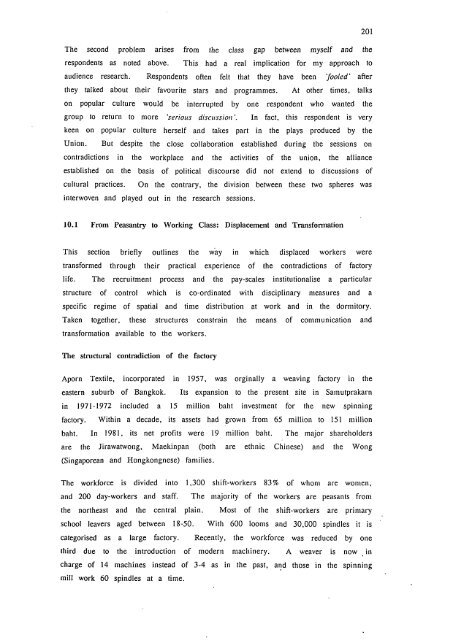iieiiei1eWrkers - Leicester Research Archive - University of Leicester
iieiiei1eWrkers - Leicester Research Archive - University of Leicester
iieiiei1eWrkers - Leicester Research Archive - University of Leicester
Create successful ePaper yourself
Turn your PDF publications into a flip-book with our unique Google optimized e-Paper software.
The second problem arises from the class gap between myself and the<br />
respondents as noted above. This had a real implication for my approach to<br />
audience research. Respondents <strong>of</strong>ten felt that they have been 'fooled' after<br />
they talked about their favourite stars and programmes. At other times, talks<br />
on popular culture would be interrupted by one respondent who wanted the<br />
group to return to more 'serious discussion'. In fact, this respondent is very<br />
keen on popular culture herself and takes part in the plays produced by the<br />
Union. But despite the close collaboration established during the sessions on<br />
contradictions in the workplace and the activities <strong>of</strong> the union, the alliance<br />
established on the basis <strong>of</strong> political discourse did not extend to discussions <strong>of</strong><br />
cultural practices. On the contrary, the division between these two spheres was<br />
interwoven and played out in the research sessions.<br />
10.1 From Peasantry to Working Class: Displacement and Transfonnation<br />
This section briefly outlines the way in which displaced workers were<br />
transformed through their practical experience <strong>of</strong> the contradictions <strong>of</strong> factory<br />
life. The recruitment process and the pay-scales institutionalise a particular<br />
structure <strong>of</strong> control which is co-ordinated with disciplinary measures and a<br />
specific reginie <strong>of</strong> spatial and time distribution at work and in the dormitory.<br />
Taken together, these structures constrain the means <strong>of</strong> communication and<br />
transformation available to the workers.<br />
The structural contradiction <strong>of</strong> the factory<br />
Aporn Textile, incorporated in 1957, was orginally a weaving factory in the<br />
eastern suburb <strong>of</strong> Bangkok. Its expansion to the present site in Sainutprakarn<br />
in 1971-1972 included a 15 million baht investment for the new spinning<br />
factory. Within a decade, its assets had grown from 65 million to 151 million<br />
baht. In 1981, its net pr<strong>of</strong>its were 19 million baht. The major shareholders<br />
are the Jirawatwong, Maekinpan (both are ethnic Chinese) and the Wong<br />
(Singaporcan and Hongkongnese) families.<br />
The workforce is divided into 1,300 shift-workers 83% <strong>of</strong> whom are women,<br />
and 200 day-workers and staff. The majority <strong>of</strong> the workers are peasants from<br />
the northeast and the central plain. Most <strong>of</strong> the shift-workers are primary<br />
school leavers aged between 18-50. With 600 looms and 30,000 spindles it is<br />
categorised as a large factory. Recently, the workforce was reduced by one<br />
third due to the introduction <strong>of</strong> modern machinery. A weaver is now in<br />
charge <strong>of</strong> 14 machines instead <strong>of</strong> 3-4 as in the past, and those in the spinning<br />
mill work 60 spindles at a time.<br />
201














